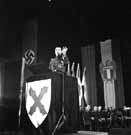
|
|
|

|

|

|

|
|
Click on an image to see a larger, more detailed picture.
|
|
|
|
|
| 1943: Death and Resistance |

|
pg. 416 |

|
|
|
|
| |
 For most Jews, the length of time spent in extermination camps was brutally abbreviated. The horrifying efficiency of the Nazi death apparatus is captured by "Entrance Through the Gate, Exit Through the Chimney," an ink drawing by Holocaust survivor Joseph Bau.
For most Jews, the length of time spent in extermination camps was brutally abbreviated. The horrifying efficiency of the Nazi death apparatus is captured by "Entrance Through the Gate, Exit Through the Chimney," an ink drawing by Holocaust survivor Joseph Bau.
Photo: Gerald Gustafson Photography
|
 Cardinal Konrad Graf von Preysing, the bishop of Berlin during the Nazi era, viewed the Third Reich as a corrupt and pernicious regime. As early as May 1933, Preysing challenged the ideological tenets of Nazism and openly called for their repudiation. By January 1943 he was the only top German Catholic prelate who consistently opposed the German government's Jewish policies. Preysing threatened to resign his post if the other German bishops continued their collaborative behavior.
Cardinal Konrad Graf von Preysing, the bishop of Berlin during the Nazi era, viewed the Third Reich as a corrupt and pernicious regime. As early as May 1933, Preysing challenged the ideological tenets of Nazism and openly called for their repudiation. By January 1943 he was the only top German Catholic prelate who consistently opposed the German government's Jewish policies. Preysing threatened to resign his post if the other German bishops continued their collaborative behavior.
Photo: Bundesarchiv / United States Holocaust Memorial Museum Photo Archive
|
 Léon Degrelle was the leader of the Belgian collaborationist group known as the Rexist movement. The Rexists were explicitly pro-Nazi. In 1943 Degrelle announced his plans to incorporate Belgium into the German empire. While Degrelle enhanced his power, the Rexists were largely excluded from political power. Moreover, many followers of the collaborationist movement became the targets of a ruthless assassination campaign carried out by the Belgian Resistance forces.
Léon Degrelle was the leader of the Belgian collaborationist group known as the Rexist movement. The Rexists were explicitly pro-Nazi. In 1943 Degrelle announced his plans to incorporate Belgium into the German empire. While Degrelle enhanced his power, the Rexists were largely excluded from political power. Moreover, many followers of the collaborationist movement became the targets of a ruthless assassination campaign carried out by the Belgian Resistance forces.
Photo: Zucca/BHVP
|
|

|

|

|

|
 January 15, 1943: A non-Jewish Polish woman and her one-year-old child are shot at the Pilica River in Poland because the woman has aided Jews.
January 15, 1943: A non-Jewish Polish woman and her one-year-old child are shot at the Pilica River in Poland because the woman has aided Jews.
|
 January 15, 1943: Seventy-seven Jews leap from a deportation train traveling east from Belgium. Most are hunted down and killed by German and Flemish SS troops.
January 15, 1943: Seventy-seven Jews leap from a deportation train traveling east from Belgium. Most are hunted down and killed by German and Flemish SS troops.
|
 January 15, 1943: Thousands of Jews at the Zaslaw, Poland, concentration camp are deported to the Belzec death camp.
January 15, 1943: Thousands of Jews at the Zaslaw, Poland, concentration camp are deported to the Belzec death camp.
|
|
|
|
|
| 1943: Death and Resistance |

|
pg. 416 |

|
|
The Holocaust Chronicle
© 2009 Publications International, Ltd.
|
|
